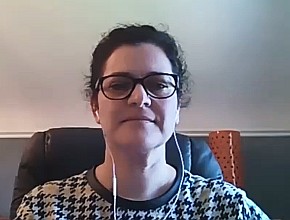Dr Harriette Van Spall, associate professor in the Division of Cardiology at McMaster University, scientist at the Population Health Research Institute, and cardiologist at Hamilton Health Sciences, joins Dr Roman Jaeschke to trace the evolution of vasodilators used in heart failure treatment.
Roman Jaeschke, MD, MSc: Good evening. Welcome to another edition of McMaster Perspective. We’re with our star performer, Prof Harriette Van Spall.
We’ve spoken about the initial impulse to record this series of interviews being an analysis of the revolution that is occurring in heart failure treatment. We’ll come back to what combinations of different treatments can do, but I would like to focus in this segment on a specific area. That’s an area that I lived through being at McMaster University. It started from the HOPE (Heart Outcomes Prevention Evaluation) trial, with ramipril, years ago. We went from angiotensin-converting enzyme (ACE) inhibitors toward angiotensin-receptor blockers (ARBs). We were cruising nicely trying to figure out which one is better until the trial of a drug with an absolutely impossible combination of names came and even more difficult to remember dosages. I would like to ask Prof Van Spall to talk to us about that particular revolution.
Harriette Van Spall, MD, MPH: So we are going to talk about the PARADIGM-HF (Prospective Comparison of ARNI with ACEI to Determine Impact on Global Mortality and Morbidity in Heart Failure) trial. It was published in 2014, so it’s been quite a while, but there has still been suboptimal uptake of the drug, which is sacubitril/valsartan, in many clinical settings.
Roman Jaeschke: Because of the name. The uptake is slow because of the name. I have no doubt.
Harriette Van Spall: Perhaps.
This drug was tested after a single-blind run-in period, following which patients were randomized to either enalapril 10 mg twice a day or sacubitril/valsartan 200 mg twice a day. There were 8442 patients with heart failure with reduced ejection fraction (HFrEF). The inclusion criteria stipulated a New York Heart Association (NYHA) class II to IV symptoms, but the patients were primarily symptomatic with NYHA class II or III symptoms. So these were not hospitalized patients. These were ambulatory patients with HFrEF.
The primary composite endpoint was cardiovascular death or heart failure hospitalization. The follow-up period was about 27 months, at which point the hazard ratio among these patients who were on sacubitril/valsartan was 0.80, and the confidence interval was about 0.73 to 0.87 or something in that range. It was well below 1.00.
Roman Jaeschke: To translate it: about 20% of the risk of your outcomes was removed. But more importantly, from what I’ve seen there’s actually a 2% absolute decrease in mortality—not in cardiovascular mortality, but in total mortality, which is quite difficult to show in any disease.
Harriette Van Spall: Right. The absolute risk reduction was quite impressive and important to note. The criticism of this trial has been that the patients in the enalapril group were not at target-dose enalapril therapy and that there was a run-in phase that selected those patients who tolerated the drug well and would adhere to the therapy. That said, it was quite a remarkable improvement in the hazard ratio and it gives pause to consider many patients who are on ACE inhibitors who may be stable or somewhat symptomatic but somehow do not get switched to this newer class of agents.
I should say that this drug was also tested in the inpatient setting in a smaller group of patients with HFrEF of about 880. The primary endpoint for this smaller trial, which was the PIONEER-HF (Comparison of Sacubitril/Valsartan Versus Enalapril on Effect on NT-proBNP in Patients Stabilized from an Acute Heart Failure Episode) trial, was a surrogate endpoint of N-terminal pro–B-type natriuretic peptide (NT-proBNP) improvement. Patients were hospitalized with acute decompensated heart failure and had no hypotension and no unstable intravenous (IV) therapy, so they had stable IV diuretic therapies, no IV vasodilators in the preceding several hours, no IV inotropes. They were then randomized to sacubitril/valsartan 200 mg twice a day or enalapril 10 mg twice a day.
The primary endpoint, which was the time-averaged proportional change in NT-proBNP, was improved in the sacubitril/valsartan group. Of course this is a surrogate endpoint and it means less than a clinical endpoint, but there were safety endpoints included in this trial and they showed that the drug was safe in the inpatient setting, with no more renal dysfunction, hyperkalemia, or hypotension among patients who are on sacubitril/valsartan. So I would say that the time to initiate this class of medications can be in the inpatient setting.
This study also included patients who had not been on ACE inhibitors in the past, so these were patients with de novo heart failure.
I would say the take-home points from these 2 trials are that this is a great and safe drug to use in patients with HFrEF as long as they don’t have contraindications. The drug can be started in ambulatory patients with NYHA class II to III symptoms but also among hospitalized patients with NYHA class IV symptoms. As long as you initiate the therapy and uptitrate it carefully, you could send patients home, follow them up in an outpatient setting, and then continue to uptitrate the drug.
Roman Jaeschke: You also mentioned doses: 50, 100, 200. From what I recall, the dosages of this drug are very strange. Could we reconcile this dosage ordering?
Harriette Van Spall: You can look it up in an app or a pharmacotherapy book, because yes, some people find it strange. Sacubitril/valsartan has 2 components. There’s a 24/26 mg pill, and you could just call it 50 mg twice a day. There’s a 49/51 mg pill, which is basically 100 mg twice a day. And then there’s a 97/103 mg pill. The first component reflects the sacubitril dose, the second is the valsartan dose.
Roman Jaeschke: I have to say it’s very useful and it finally makes sense. Fantastic.
Harriette Van Spall: It’s not as tricky. I would say you could start low, at 50 mg twice a day, and uptitrate every 2 to 3 weeks, until you hit the target dose. You would monitor potassium and creatinine as well as blood pressure levels. You want to make sure patients aren’t getting hypotensive with the drug. And you don’t want to initiate it in patients who are hyperkalemic, have an estimated glomerular filtration rate (eGFR) less than 30 mL/min/1.73 m2, or have a resting blood pressure less than 90 mm Hg.
It's important to remember that if you are switching from an ACE inhibitor to an angiotensin receptor–neprilysin inhibitor (ARNI), you need a washout period of 36 hours to decrease the risk of angioedema. That’s an important thing to note.
When you’re starting in the hospital, again, you could start low and then uptitrate slow. So you could uptitrate it every 1 week or so, keeping in mind the length of stay on average for patients who are in with decompensated heart failure is more than 7 days.
Roman Jaeschke: That’s a very nice building block of our heart failure knowledge.
We’ll come back to combine all this in the next interview. Thank you very much. I really appreciate it.
Harriette Van Spall: My pleasure. Thank you for inviting me.
 English
English
 Español
Español
 українська
українська










